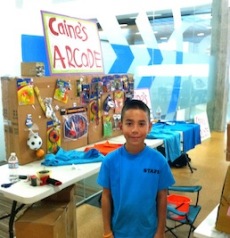 This past Saturday, October 6, kids in over 30 countries in 6 continents participated in the Global Cardboard Challenge, the next chapter from the folks that brought you the short film “Caine’s Arcade.” The fanfare around the film, featuring a 9 year-old Hispanic boy named Caine’s elaborate handmade cardboard arcade, was the impetus for the formation of the Imagination Foundation. The non-profit, founded by “Caine’s Arcade” filmmaker Nirvan Mullick, aims to “help find, fund, and foster creativity and entrepreneurship in kids.” The Foundation is currently developing programs supporting kid-friendly makerspaces and providing opportunities for STEAM education (which means placing the arts & humanities very much into the center of STEM education).
This past Saturday, October 6, kids in over 30 countries in 6 continents participated in the Global Cardboard Challenge, the next chapter from the folks that brought you the short film “Caine’s Arcade.” The fanfare around the film, featuring a 9 year-old Hispanic boy named Caine’s elaborate handmade cardboard arcade, was the impetus for the formation of the Imagination Foundation. The non-profit, founded by “Caine’s Arcade” filmmaker Nirvan Mullick, aims to “help find, fund, and foster creativity and entrepreneurship in kids.” The Foundation is currently developing programs supporting kid-friendly makerspaces and providing opportunities for STEAM education (which means placing the arts & humanities very much into the center of STEM education).
The Foundation launched the Global Cardboard Challenge, an annual worldwide day of play and tinkering coinciding with the one-year anniversary of the flash mob Nirvan organized to surprise Caine with a big group of people eager to play his inventive games. Each Global Cardboard Challenge event this weekend was organized by local organizations and community groups in schools, museums, libraries, churches, and even in kitchens and backyards, all sharing information via Facebook or the event’s online hub. From Hong Kong to Homer, Alaska, friends, families, and community members came out to celebrate kids’ imaginative creations made out of cardboard and other recycled materials.
I spent a few hours on Saturday at the flagship Global Cardboard Challenge event in Boyle Heights, across the street from the original Caine’s Arcade. I’ve posted about Caine’s Arcade on this blog before, both the film and the physical location in East LA. I met Nirvan, Caine, and Caine’s dad George a couple weeks after the flashmob, when Nirvan screened an early version of the film at the DIY Days conference, and I have also been volunteering as an educational advisor to the Imagination Foundation.
Earlier this year, upon the worldwide release of the film on YouTube and Vimeo, I wrote, “Caine’s Arcade is a timely and brilliant example of how our society needs to rethink the ways of doing and thinking that connect children to larger bodies of knowledge and allow them to share their creations with a larger public.” Having spent a great deal of time walking around the event on Saturday, talking with kids and their parents about what brought them there, I want to slightly tweak my earlier observation. I think this Caine’s Arcade transmedia universe not only can support children‘s learning across media, but also help to connect parents who might not otherwise have the opportunities to participate as well.
One conversation in particular stuck with me, emphasizing the importance of diverse types of parent engagement, in school and out-of-school contexts. I walked up to two little girls working on building handles so that they could walk around with a large handpainted cardboard Caine’s Arcade sign. I asked one of their mothers how she had first heard of the event. Realizing that English was not her primary language, I tried again in Spanish, asking if perhaps they had watched the “Caine’s Arcade” movie online at home. She told me that they do not have internet access at home, and then called her daughter over to speak to me. Her daughter’s English was much better than my Spanish, and I worried that I might have made the mother uncomfortable by asking first in English. The girl eagerly said that she had seen both the first and second follow-up “Caine’s Arcade” short films at school, and had told her mom about the Global Cardboard Challenge event.
The exchange brought to mind for me the dissertation of a 2007 graduate of my Ph.D. program in Communication at USC Annenberg and current Asst. Professor of Communication at Rutgers, Vikki Katz. In particular, I thought of an article of hers, based off of her dissertation work, published in the Journal of Children and Media and entitled “How children of immigrants use media to connect their families to the community: The case of Latinos in South Los Angeles” (2010).
In it, Katz describes how while most research on children and media in the home focus on majority culture, middle-class families, little research focuses on immigrant families and the ways in which children in those families “broker” new and traditional media forms to connect their families to local resources. Most of these children speak both the majority and minority language while many parents are monolingual. Thus, the children not only translate information from media artifacts such as newspapers and TV, but also advocate on behalf of their parents and help connect them with community resources. Writes Katz, “For parents who are unable to interact in the majority language, children broker connections to media to compensate for their parents’ limited traditional and new media literacies” (p. 299). Katz’s research “highlights the need for serious explorations into how race/ethnicity, immigration status, and class may affect children’s media worlds and relationships to communication technologies” (p. 331). The little girl I talked to would never have watched the “Caine’s Arcade” video at home, and thus through her internet access at school and her teachers’ interest in “Caine’s Arcade,” brokered her mother’s inclusion in this community event in Boyle Heights, which was also attended by other community arts groups and youth outreach organizations.
The “Caine’s Arcade” film has engaged many parents through its spread across the internet, and indeed, I talked to many parents living in East LA and South LA who saw the film on YouTube and heard about the Global Cardboard Challenge event through using Facebook. In order to engage all kinds of families in children’s formal and informal learning opportunities, such as the kinds proposed by the Imagination Foundation, it is of vital importance to understand the media worlds of language minority groups in the US, and to recognize the multi-faceted nature of the kinds of resources parents have access to and feel most comfortable engaging with.
Photos by Meryl Alper



